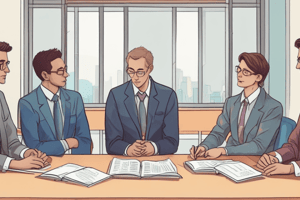Podcast
Questions and Answers
What are the three levels of management mentioned in the text?
What are the three levels of management mentioned in the text?
- Technical, Human (Interpersonal), Conceptual
- Type A, Type B, Type C (correct)
- Individual, Group, Organizational
- Recruitment, Selection, Development
Which of these are considered 'hard benefits' that contribute to a positive work environment?
Which of these are considered 'hard benefits' that contribute to a positive work environment?
- Salary and extra benefits (correct)
- Work-life balance
- Growth opportunities
- Company culture and climate
Which of these is NOT a daily activity or task often assigned to a Work and Organizational Psychologist?
Which of these is NOT a daily activity or task often assigned to a Work and Organizational Psychologist?
- Analyzing financial data to determine organizational growth projections (correct)
- Developing training programs for new employees
- Conducting research on employee well-being
- Designing and implementing interventions to improve employee well-being
What is the main focus of Work and Organizational Psychology?
What is the main focus of Work and Organizational Psychology?
Which of these is considered a 'soft skill' that is transferable across different jobs?
Which of these is considered a 'soft skill' that is transferable across different jobs?
What are the three levels of analysis in Work and Organizational Psychology, as mentioned in the text, that are used to understand behavior?
What are the three levels of analysis in Work and Organizational Psychology, as mentioned in the text, that are used to understand behavior?
Which of these is a possible source for identifying 'best places to work' based on factors like growth opportunities and work-life balance?
Which of these is a possible source for identifying 'best places to work' based on factors like growth opportunities and work-life balance?
What is the term for the process of integrating new employees into an organization, which can be considered a team-building activity?
What is the term for the process of integrating new employees into an organization, which can be considered a team-building activity?
What characterizes the Adjourning stage of group development?
What characterizes the Adjourning stage of group development?
What is the primary factor that influences a group's speed in progressing through the stages of group development?
What is the primary factor that influences a group's speed in progressing through the stages of group development?
Which stage of group development is characterized by a clear understanding of roles and a focus on performance?
Which stage of group development is characterized by a clear understanding of roles and a focus on performance?
What is the most significant characteristic of the Punctuated-Equilibrium Model?
What is the most significant characteristic of the Punctuated-Equilibrium Model?
What is the term used to describe the effect where the combined effort of a group is greater than the sum of its individual efforts?
What is the term used to describe the effect where the combined effort of a group is greater than the sum of its individual efforts?
Which of the following is NOT a characteristic of large groups?
Which of the following is NOT a characteristic of large groups?
What is the primary concern with small groups?
What is the primary concern with small groups?
What is the term used to describe the tendency for individuals to exert less effort when working collectively than when working alone?
What is the term used to describe the tendency for individuals to exert less effort when working collectively than when working alone?
Which of these values are NOT mentioned as core values that influence organizational culture?
Which of these values are NOT mentioned as core values that influence organizational culture?
What are the two dimensions on which most organizational cultures vary according to the Competing Values Culture Model?
What are the two dimensions on which most organizational cultures vary according to the Competing Values Culture Model?
Which type of organizational culture is characterized by a formalized and structured workplace, emphasizing efficiency and smooth functioning?
Which type of organizational culture is characterized by a formalized and structured workplace, emphasizing efficiency and smooth functioning?
Which of these sectors typically employ organizations with a Control/Hierarchical culture?
Which of these sectors typically employ organizations with a Control/Hierarchical culture?
Which of these describes the main characteristic of a Compete/Market Culture?
Which of these describes the main characteristic of a Compete/Market Culture?
Which of the following is NOT a typical characteristic of a strong organizational culture?
Which of the following is NOT a typical characteristic of a strong organizational culture?
What is the primary function of subcultures within an organization?
What is the primary function of subcultures within an organization?
Which of these is NOT one of the four competing value sets mentioned in the Competing Values Culture Model?
Which of these is NOT one of the four competing value sets mentioned in the Competing Values Culture Model?
According to the content, what is the main reason why emotions were previously considered disruptive in the workplace?
According to the content, what is the main reason why emotions were previously considered disruptive in the workplace?
Which of the following is NOT a core dimension of any job, as defined by the Job Characteristics Model?
Which of the following is NOT a core dimension of any job, as defined by the Job Characteristics Model?
The text mentions 'Lived Experience' as a factor influencing organizational processes. What does 'Lived Experience' primarily refer to in this context?
The text mentions 'Lived Experience' as a factor influencing organizational processes. What does 'Lived Experience' primarily refer to in this context?
According to the content, how does employee involvement contribute to increased autonomy?
According to the content, how does employee involvement contribute to increased autonomy?
Which of the following is NOT a common source of emotions and moods discussed in the content?
Which of the following is NOT a common source of emotions and moods discussed in the content?
The content suggests that a key difference between emotions and moods lies in:
The content suggests that a key difference between emotions and moods lies in:
Which of these statements aligns with the emerging understanding of emotions in the workplace, as discussed in the content?
Which of these statements aligns with the emerging understanding of emotions in the workplace, as discussed in the content?
According to the content, how is 'external reward' related to the concept of avoiding punishment?
According to the content, how is 'external reward' related to the concept of avoiding punishment?
Which personality trait is most crucial for success in a wide range of job settings?
Which personality trait is most crucial for success in a wide range of job settings?
Individuals who are highly extroverted are typically described as:
Individuals who are highly extroverted are typically described as:
Which personality trait is particularly important for roles that require a high level of emotional resilience and composure?
Which personality trait is particularly important for roles that require a high level of emotional resilience and composure?
Individuals low in agreeableness tend to be:
Individuals low in agreeableness tend to be:
Which of the following occupations is most likely to require a high level of openness to experience?
Which of the following occupations is most likely to require a high level of openness to experience?
Which personality trait is most beneficial for roles that require strong communication and social skills?
Which personality trait is most beneficial for roles that require strong communication and social skills?
Which personality trait is most likely to hinder individuals from working effectively in teams?
Which personality trait is most likely to hinder individuals from working effectively in teams?
What is the main concern about using self-report personality tests for hiring decisions?
What is the main concern about using self-report personality tests for hiring decisions?
Which of the following is NOT a level of determinants influencing people's behavior in an organization, according to the text provided?
Which of the following is NOT a level of determinants influencing people's behavior in an organization, according to the text provided?
What is the primary focus of the MARS model in understanding individual behavior and performance?
What is the primary focus of the MARS model in understanding individual behavior and performance?
Why is it important to consider the impact of perception on individual behavior?
Why is it important to consider the impact of perception on individual behavior?
What is the main purpose of analyzing individual aspects within the context of organizational behavior?
What is the main purpose of analyzing individual aspects within the context of organizational behavior?
What is the significance of the predictive validity of personality in the context of organizational behavior?
What is the significance of the predictive validity of personality in the context of organizational behavior?
What is a key ethical challenge highlighted in the text related to the application of psychology in organizational contexts?
What is a key ethical challenge highlighted in the text related to the application of psychology in organizational contexts?
What aspect of the text suggests a possible shift in the role of psychology in the future?
What aspect of the text suggests a possible shift in the role of psychology in the future?
What is the potential downside of psychologists becoming involved in prescribing medication?
What is the potential downside of psychologists becoming involved in prescribing medication?
Flashcards
Work & Organizational Psychology
Work & Organizational Psychology
A field studying human behavior in work settings to enhance productivity and organizational success.
W/O Psychologists
W/O Psychologists
Professionals who research employee behavior and apply psychology to optimize organizational success.
Human Skills
Human Skills
Interpersonal skills that help individuals understand and motivate others in a work environment.
Technical Skills
Technical Skills
Signup and view all the flashcards
Conceptual Skills
Conceptual Skills
Signup and view all the flashcards
Management Levels
Management Levels
Signup and view all the flashcards
Work-life Balance
Work-life Balance
Signup and view all the flashcards
Recruitment Process
Recruitment Process
Signup and view all the flashcards
Client Contracts
Client Contracts
Signup and view all the flashcards
Remote Service Competencies
Remote Service Competencies
Signup and view all the flashcards
Confidentiality Limitations
Confidentiality Limitations
Signup and view all the flashcards
Fees for Remote Services
Fees for Remote Services
Signup and view all the flashcards
Ethical Responsibilities
Ethical Responsibilities
Signup and view all the flashcards
Invisible Third Parties
Invisible Third Parties
Signup and view all the flashcards
Determinants of Behavior
Determinants of Behavior
Signup and view all the flashcards
MARS Model
MARS Model
Signup and view all the flashcards
Dominant Culture
Dominant Culture
Signup and view all the flashcards
Subcultures
Subcultures
Signup and view all the flashcards
Strong Culture
Strong Culture
Signup and view all the flashcards
Weak Culture
Weak Culture
Signup and view all the flashcards
Competing Values Culture Model
Competing Values Culture Model
Signup and view all the flashcards
Control/Hierarchical Culture
Control/Hierarchical Culture
Signup and view all the flashcards
Compete/Market Culture
Compete/Market Culture
Signup and view all the flashcards
Organizational Culture Assessment Instrument (OCAI)
Organizational Culture Assessment Instrument (OCAI)
Signup and view all the flashcards
Self-report tests
Self-report tests
Signup and view all the flashcards
Big Five Personality Model
Big Five Personality Model
Signup and view all the flashcards
Extraversion
Extraversion
Signup and view all the flashcards
Agreeableness
Agreeableness
Signup and view all the flashcards
Conscientiousness
Conscientiousness
Signup and view all the flashcards
Emotional stability
Emotional stability
Signup and view all the flashcards
Openness to experience
Openness to experience
Signup and view all the flashcards
Job performance predictor
Job performance predictor
Signup and view all the flashcards
Key Elements of Motivation
Key Elements of Motivation
Signup and view all the flashcards
Content Models of Motivation
Content Models of Motivation
Signup and view all the flashcards
Process Models of Motivation
Process Models of Motivation
Signup and view all the flashcards
Theory X
Theory X
Signup and view all the flashcards
Theory Y
Theory Y
Signup and view all the flashcards
Motivating Potential Score (MPS)
Motivating Potential Score (MPS)
Signup and view all the flashcards
Emotional Intelligence
Emotional Intelligence
Signup and view all the flashcards
Sources of Emotions and Moods
Sources of Emotions and Moods
Signup and view all the flashcards
Performing Stage
Performing Stage
Signup and view all the flashcards
Adjourning Stage
Adjourning Stage
Signup and view all the flashcards
Punctuated-Equilibrium Model
Punctuated-Equilibrium Model
Signup and view all the flashcards
Synergy
Synergy
Signup and view all the flashcards
Optimal Group Size
Optimal Group Size
Signup and view all the flashcards
Social Loafing
Social Loafing
Signup and view all the flashcards
Transition Point
Transition Point
Signup and view all the flashcards
Group Effectiveness
Group Effectiveness
Signup and view all the flashcards
Study Notes
Work & Organizational Psychology
- Work-life balance is a topic covered in the course
- Topics also include organization and context, role of psychologists, and HR management, including counter-productive behaviors at work.
- Exam format involves 25 multiple-choice questions (mcqs), with a focus on lectures, readings, slides, and case studies.
Lecture 1: Organization and Context of Its Functioning
- What Do W/O Psychologists Do?: Work and Organizational Psychology is a division of psychology focusing on human behavior related to work, organizations, and productivity.
- W/O psychologists research employees and apply psychological principles to optimize organizational success (Schultz and Schultz, 2014).
- W/O psychologists conduct daily activities such as team building, problem-solving conflict resolution, recruitment, selection, and training.
- They focus on development (not just recruitment), coaching, mentoring, and statistics-based research and consulting.
- They design and implement activities for improving employee well-being and work-related interventions.
- WOP is a multidisciplinary field offering organizational perspectives using a managerial and psychological lens.
Management Skills
- Technical Skills: The specialized knowledge applied to a job, typically gained through experience or on the job training.
- Human Skills: Skills enabling interaction, understanding, and motivation of individuals and groups (e.g., empathy, teamwork, communication, conflict resolution).
- Conceptual Skills: Cognitive abilities to analyze, diagnose, and solve complex issues (e.g., critical thinking, innovation).
Lecture 2. The Past and Present of WOP
- Human interpersonal skills are critical for leadership and career progression.
- Stronger interpersonal skills result in improved employee retention and better recruitment applications.
- "Good workplaces" are often associated with better financial performance.
The Beginnings of Organizational Psychology
- Key figures include Munsterberg, Scott, and Taylor
- Munsterberg focused on work design and individual differences in job performance.
- Scott focused on salesmanship and advertising psychology.
- Taylor's scientific management method focused on optimizing work efficiency and productivity through procedures like time-and-motion studies.
- Mayo's work explored the impact of the physical work environment on worker productivity.
The Changing Nature of Work
- Important trends include downsizing, outsourcing, remote working, and AI use.
- Outsourcing and remote working have become integral.
Expanding Focus on Human Resources
- Includes talent management, individual development, and work-life balance.
Increasing Diversity and Globalization of the Workforce
- Workforce diversity and globalization are factors in organizational functioning, global marketplace, and team functions.
Increasing Relevance of I/O Psychology in Policy and Practice
- I/O psychology is relevant in making work conditions suitable, talent selection, and leader development; reducing discrimination.
21st Century Challenges for Psychology
- Delivering services over substantial distances (telepsychology)
- Identifying clients, and the role of the invisible (in a psychological context)
Telepsychology
- Traditional standards and agreements regarding client relationships must be rethought when using remote technologies.
- Ethical responsibilities to individuals and society at large are key components
- Confidentiality protections must align with remote technologies.
Witnessing the Demise of Psychiatry
- The value of psychology as an alternative and non-medical intervention is highlighted.
- The benefits of prescribed/chemical interventions versus alternative talk interventions is highlighted.
Mini Case Study
- Decision-making examples focusing on ethical considerations based on limited information
L3. Determinants of People's Behavior in the Organization (1)
- Individual factors like personality, values, emotions, perception, and decision making, impacting workplace performance.
- Introduces the MARS Model of Individual Behaviour and performance.
Perception and Selectivity
- People's behaviour is influenced by perception.
- Perception, is a cognitive activity, not direct reality.
- Factors that influence perception include; time, work setting, social setting, perceiver's attributes (attitudes, motives, experience, expectations), and target characteristics (novelty, motion, sounds, size, background, proximity, similarity).
Perception and Expectation
- Halo/Horn effect – one characteristic influences overall impression of a person.
- Contrast effects – perception is influenced by previous encounters.
- Self-fulfilling prophecy. Beliefs affect behavior.
- Theory X and Theory Y (McGregor) – assumptions about employee motivation.
Defining Personality
- Personality traits impact how individuals react to and interact with others in the workplace.
- Personality is a comprehensive characteristic of an individual.
- Major models of assessing personality include Big Five.
Agreeableness, Conscientiousness, Emotional Stability, Openness, and Extraversion
- Personality traits influence behaviour, job performance, and success, in the workplace.
L4. Determinants of People's Behavior in the Organization (2)
- Group level factors and the differences between groups and teams, roles, and performance.
- Focuses on group dynamics.
- Key terms include work group, work team, and several types of groups (formal/informal).
Group Development Stages
- Five stages: Prestage, Forming, Storming, Norming, Performing, and Adjourning.
- Group effectiveness varies as groups navigate these stages.
- The punctuated equilibrium model, focusing on the dynamics of temporary groups with deadlines.
Group Size and Performance
- Synergy in groups: the effect of a combination exceeding the sum of its components
- Optimum group size varies according to work type.
L5. Determinants of People's Behavior in the Organization (3)
- Organizational structure and relationships between positions in a company.
- Key concepts include chain of command, span of control, and organizational chart.
Organizational Structure Types
- Traditional ("mechanistic" or "bureaucratic") structures – hierarchies, rules, formal roles.
- Nontraditional ("organic") structures – adaptable, less formalized, flat hierarchies.
L6. The Role of a Psychologist in Organizational Processes
- Human Resources Management (HRM), Marketing Psychology, Consumer Behavior, and Economic Psychology are four major focus areas.
- Evolution of HRM to encompass "people and culture".
- Performance management, talent inventory/forecasting.
Lecture 7: The Role of a Psychologist in Organizational Processes
- Methods utilized in recruitment; red flags for HR managers; career options in HR.
- Employee research, satisfaction surveys; learning and development; organizational change and development; well-being and mental health
- Balanced demands on employee and organizations.
Lecture 8. The Role of a Psychologist in Organizational Processes (Motivation)
- Key elements of motivation (intensity, direction, and persistence).
- Motivation theories (content vs. process models).
- McGregor's Theory X and Theory Y; Five Core Dimensions of any job (Job Characteristics Model) (MPS).
- Employee involvement (increased autonomy); participative management; representative participation; lived experience.
Lecture 9: Emotions and Emotional Intelligence
- Previous view of emotions in organizations and management.
- Emotions and management; emotions in organizational settings.
- Differentiation between emotions and moods.
Lecture 10: Stress and Stress Management
- Stress as an unpleasant psychological process triggered by environmental pressures.
- Job-related stress.
- Challenge vs. hindrance stress.
- Cultural differences in stress sources and responses.
- Consequences of stress and how to manage it.
Lecture 11: Cultural Competence and Intercultural Intelligence
- Intercultural competence; emotional intelligence; interpersonal intelligence; contextual intelligence.
- Ethnocentric vs ethno-relative perspective; Etic vs Emic perspectives
- Cultural quotients.
Studying That Suits You
Use AI to generate personalized quizzes and flashcards to suit your learning preferences.




